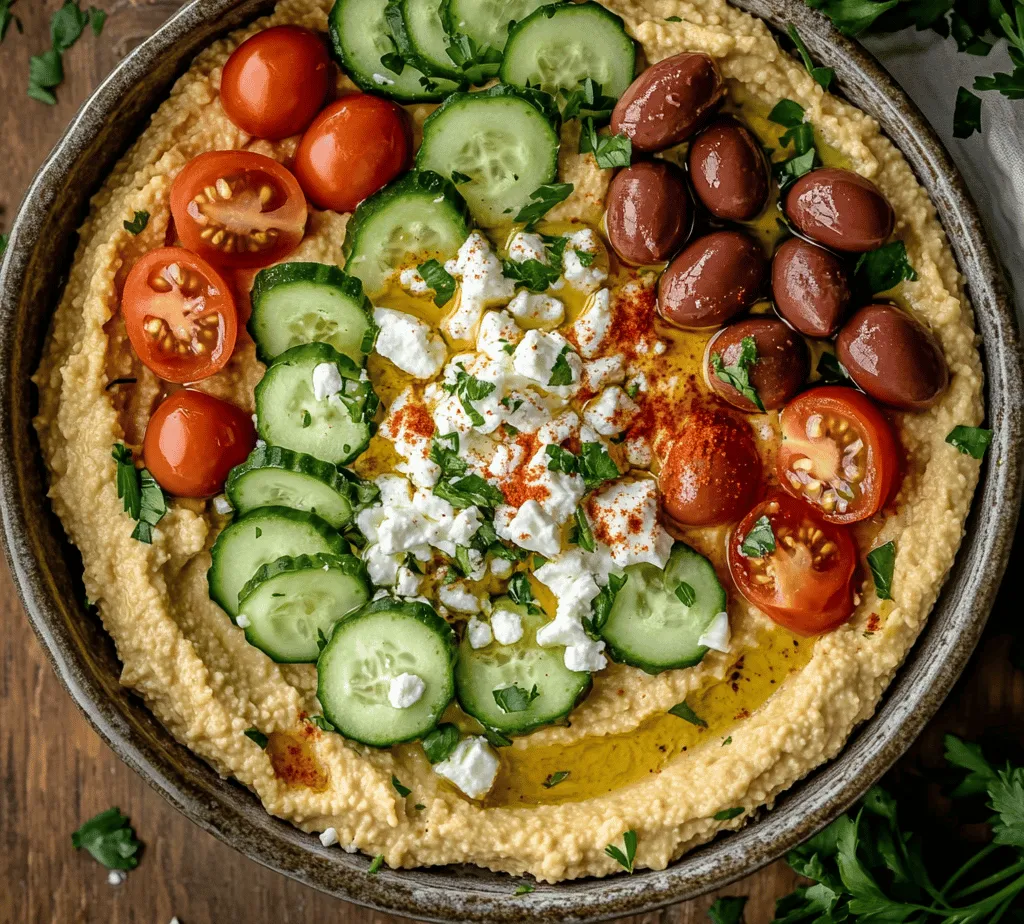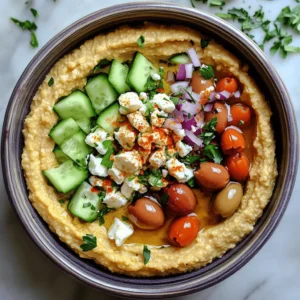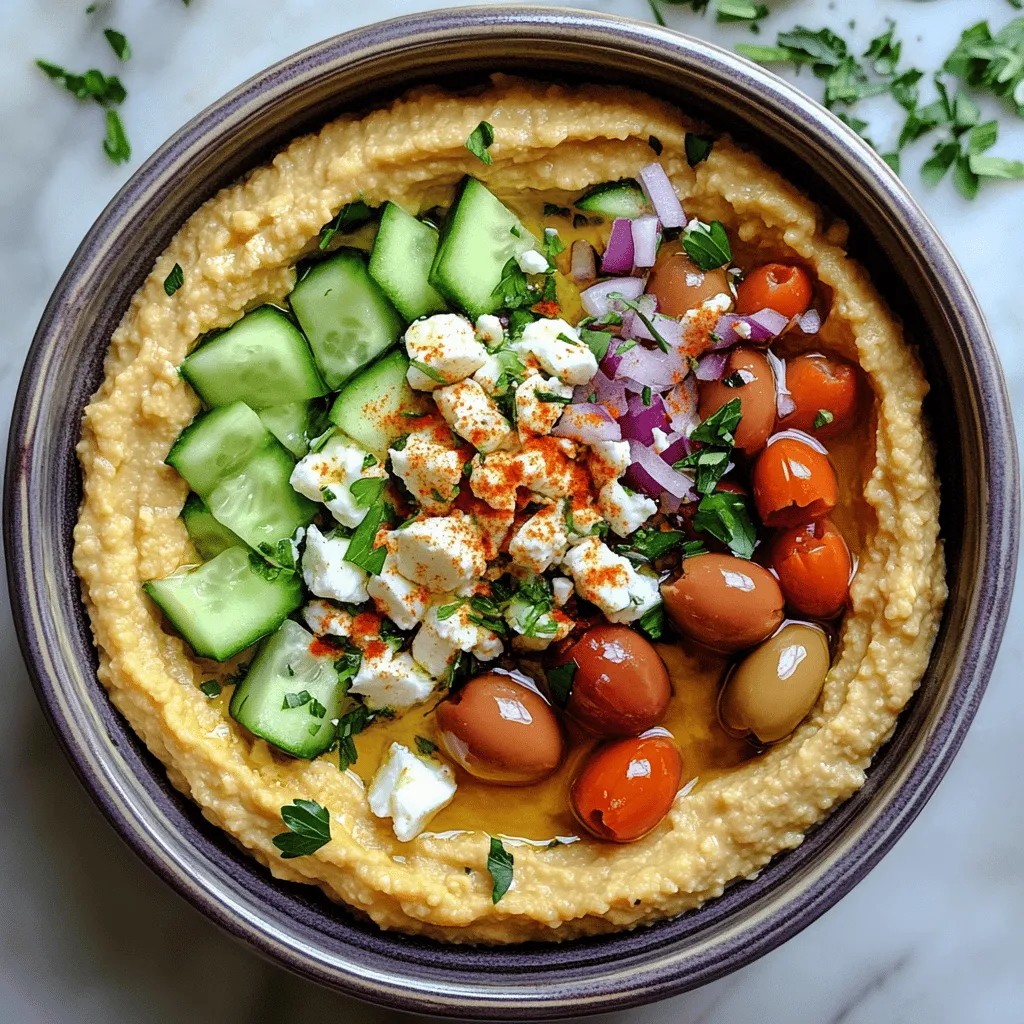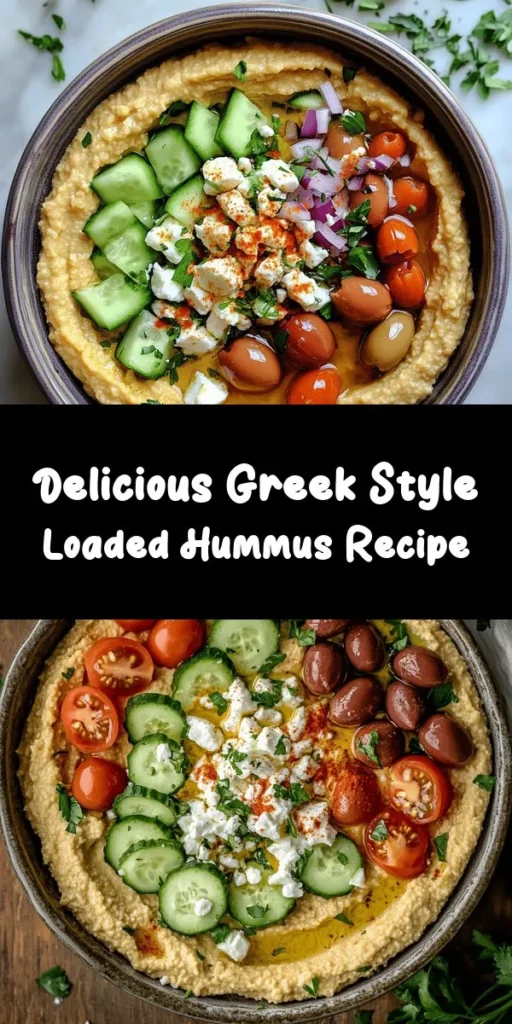Introduction
Hummus, a beloved staple of Mediterranean cuisine, has gained immense popularity worldwide as a healthy and flavorful dip. Traditionally made from blended chickpeas, tahini, olive oil, garlic, and lemon juice, this creamy spread is not only versatile but also embodies the vibrant flavors of the Mediterranean. Its cultural roots trace back thousands of years, where it served as a nourishing food for many, and today, it continues to be a staple in Middle Eastern and Mediterranean diets.
The Greek-style loaded hummus takes the classic recipe to another level by incorporating fresh, vibrant toppings that enhance both flavor and presentation. This dish is not just a dip; it’s an experience. With its rich textures and colorful toppings, it can easily steal the spotlight at any gathering, from casual family dinners to sophisticated dinner parties. The array of flavors and textures makes it an ideal dish for sharing, allowing guests to customize their servings with their favorite toppings.
Not only is Greek-style loaded hummus an appealing dish, but it is also packed with nutrition. It serves as a fantastic option for those looking to incorporate healthy, plant-based meals into their diets. The combination of chickpeas, tahini, and fresh vegetables creates a nutrient-dense dish that is sure to satisfy your cravings while nourishing your body.
The Nutritional Benefits of Hummus
At the heart of hummus lies the chickpea, also known as garbanzo beans. These legumes are a powerhouse of nutrition, offering an excellent source of plant-based protein. For those looking to maintain or build muscle, chickpeas provide the essential amino acids necessary for muscle repair and growth. Additionally, they are high in dietary fiber, which aids in digestion and helps to keep you feeling full longer. The combination of protein and fiber makes hummus a great option for anyone seeking a satisfying snack or meal.
Tahini, another key ingredient in hummus, is made from ground sesame seeds. This creamy paste is not only delicious but also brimming with health benefits. Tahini is rich in healthy fats, particularly monounsaturated fats, which can support heart health. It also provides a good amount of calcium, an essential mineral that plays a crucial role in bone health and muscle function.
Adding extra virgin olive oil to your hummus not only enhances its flavor but also contributes to its health benefits. Olive oil is a staple in Mediterranean diets and is known for its anti-inflammatory properties. Packed with antioxidants and healthy fats, it can help reduce the risk of chronic diseases, making it a heart-healthy choice.
Fresh vegetables and herbs elevate the nutritional profile of Greek-style loaded hummus even further. Toppings like cucumber, tomatoes, and bell peppers add a refreshing crunch and a wealth of vitamins and minerals. Fresh herbs such as parsley and mint not only provide a burst of flavor but also offer additional health benefits, including antioxidants and anti-inflammatory properties.
In summary, Greek-style loaded hummus is not just a tasty dish; it is a nutritional powerhouse. With its combination of chickpeas, tahini, olive oil, and fresh vegetables, this dish offers a wealth of plant-based protein, fiber, healthy fats, and essential vitamins and minerals.
Ingredients Breakdown
To create the perfect Greek-style loaded hummus, quality ingredients are key. Here’s a detailed breakdown of each component that contributes to this delicious dish:
1. Chickpeas (Garbanzo Beans): The foundation of hummus, chickpeas can be used canned or dried. If using dried chickpeas, they must be soaked overnight and cooked until tender. For convenience, canned chickpeas are a great option; just ensure they are well-rinsed to remove excess sodium.
2. Tahini: Look for high-quality tahini made from pure sesame seeds, without added oils or preservatives. The freshness of tahini can greatly influence the flavor of your hummus, so opt for brands that are known for their quality.
3. Extra Virgin Olive Oil: A good-quality extra virgin olive oil will add depth to your hummus. It’s worth investing in a bottle that is cold-pressed to capture the healthiest and most flavorful oils from the olives.
4. Garlic: Fresh garlic adds a sharp, aromatic flavor to the hummus. You can adjust the amount according to your taste preference, but typically one or two cloves should suffice.
5. Lemon Juice: Freshly squeezed lemon juice brightens the hummus and adds a tangy flavor that balances the richness of tahini and olive oil. Bottled lemon juice lacks the freshness and vibrant flavor of freshly squeezed juice.
6. Cumin and Salt: Ground cumin adds a warm, earthy flavor, while salt enhances all the other ingredients. Start with a small amount and adjust to taste.
7. Toppings: For the Greek-style twist, consider toppings such as diced cucumber, cherry tomatoes, Kalamata olives, feta cheese, and fresh herbs like parsley and mint. Each topping adds a distinct flavor and texture to the dish.
Variations and Substitutions
This recipe is highly adaptable to suit various dietary preferences and restrictions. Here are some ideas:
– Vegan Options: The base recipe is already vegan, but if you want to add toppings like feta cheese, you can substitute it with vegan feta or simply skip it for a dairy-free version.
– Gluten-Free: Hummus is naturally gluten-free, making it a great option for those with gluten sensitivities. Serve it with gluten-free pita chips, veggies, or rice crackers.
– Flavor Variations: Experiment with different flavors by adding roasted red peppers, sun-dried tomatoes, or even spicy harissa for a kick. You can also make a dessert hummus using chickpeas, cocoa powder, and maple syrup for a sweet treat.
Step-by-Step Instructions for Preparing Greek Style Loaded Hummus
Now that we’ve covered the nutritional benefits and ingredients, let’s dive into the steps for preparing your Greek-style loaded hummus. Follow these instructions for a smooth, creamy base and an impressive presentation.
Blending the Base
1. Prepare the Chickpeas: If using dried chickpeas, soak them overnight and cook until tender. If using canned chickpeas, drain and rinse them under cold water to remove excess sodium. For an ultra-smooth texture, consider peeling the skins off the chickpeas, although this step is optional.
2. Combine Ingredients: In a food processor, combine the chickpeas, tahini, garlic, lemon juice, cumin, and salt. Drizzle in a couple of tablespoons of extra virgin olive oil.
3. Blend Until Smooth: Start blending on a low speed, gradually increasing to high. Scrape down the sides of the bowl as needed. To achieve the perfect creamy texture, gradually add water—one tablespoon at a time—until the desired consistency is reached. This usually takes about 3-5 minutes of blending.
4. Taste and Adjust Seasoning: Once blended, taste your hummus and adjust the seasoning as necessary. You may want to add more salt, lemon juice, or garlic, depending on your flavor preferences.
Preparing the Serving Dish
1. Select a Serving Platter: Choose a shallow dish or a large plate for serving. The wider surface area allows for more toppings and makes for an attractive presentation.
2. Spoon the Hummus: Transfer your blended hummus into the center of the dish. Use the back of a spoon to create swirls and a slight dip in the middle. This will be where you layer your toppings.
Layering the Toppings
1. Start with Fresh Vegetables: Begin by adding diced cucumber and cherry tomatoes over the hummus. Arrange them in a circular pattern or in sections to create visual interest.
2. Add Olives and Feta: Scatter Kalamata olives around the edges, and crumble feta cheese over the top for a salty, tangy kick.
3. Drizzle with Olive Oil: Finish off the presentation by drizzling a generous amount of high-quality extra virgin olive oil across the surface of the hummus and toppings. This not only adds flavor but also gives the dish a polished look.
4. Garnish with Fresh Herbs: Finally, sprinkle freshly chopped parsley and mint over the dish for a pop of color and freshness.
With these steps, your Greek-style loaded hummus will be ready to impress guests and tantalize taste buds. The combination of creamy hummus and vibrant toppings creates a dish that is as beautiful as it is delicious. Enjoy the process, and prepare for the compliments to roll in as you share this delightful Mediterranean treat!

Adding Feta and Herbs
In crafting the perfect Greek style loaded hummus, the addition of feta cheese and fresh herbs plays a pivotal role in elevating the flavor profile. Feta, a crumbly and tangy cheese made from sheep’s or goat’s milk, introduces a rich, creamy texture that complements the smoothness of the hummus. When mixed in with the hummus, it creates a delightful contrast that enhances each bite.
Fresh herbs, such as parsley, dill, and oregano, are fundamental in Greek cuisine. Parsley adds a bright, refreshing note, while dill contributes a subtle earthiness that rounds out the dish beautifully. Oregano, a staple in Greek cooking, brings a warm, aromatic quality that can transform the hummus from a simple dip to a vibrant centerpiece. As you sprinkle these herbs over the top of your hummus, you not only enhance the visual appeal but also infuse it with layers of flavor that are quintessentially Greek.
Finishing Touches
No Greek style loaded hummus is complete without the finishing touches that truly make it shine. A generous drizzle of high-quality extra virgin olive oil is essential; this not only adds richness but also infuses the dish with its distinctive fruity flavor. Olive oil is the cornerstone of Mediterranean diets, known for its health benefits and flavor-enhancing properties. When you drizzle it over the hummus just before serving, it creates a beautiful sheen and invites the diner to dive in.
Smoked paprika is another key ingredient that should not be overlooked. This spice adds a subtle smokiness that balances the creaminess of the hummus and the saltiness of the feta. A sprinkle of smoked paprika not only enhances the flavor but also provides a beautiful contrast against the pale hue of the hummus, making it visually appealing.
Serving Suggestions
When it comes to serving your Greek style loaded hummus, the options are as diverse as they are delicious. Ideal dippers include freshly baked pita bread, which can be cut into triangles for easy scooping. Pita chips are another excellent option, providing a satisfying crunch. For a healthier alternative, consider serving veggie sticks—carrots, cucumbers, bell peppers, and celery are all excellent choices that add a refreshing crunch while complementing the hummus.
In terms of beverage pairings, this dish works beautifully with a glass of chilled white wine, such as a crisp Sauvignon Blanc or a light and fruity Pinot Grigio. If you prefer a non-alcoholic option, a refreshing lemonade or iced tea can also beautifully cleanse the palate between bites.
For gatherings or parties, Greek style loaded hummus can serve as a delightful appetizer or part of a mezze platter, surrounded by an array of other delicious dips, olives, and cheeses. This communal style of dining encourages sharing and conversation, making it the perfect dish for any social occasion. It’s also an excellent choice for a healthy snack at home, providing a satisfying option that’s both nutritious and filling.
Cultural Significance of Hummus in Greek Cuisine
Hummus holds a special place not only in Greek cuisine but also across Middle Eastern and Mediterranean diets. Its roots can be traced back centuries, with a history that reflects the culinary practices of various cultures. In Greece, hummus is often enjoyed as part of a larger spread during family gatherings and celebrations, embodying the spirit of sharing and community that is central to Greek culture.
Different regions have their own variations of hummus; for example, in Lebanon, you may find it topped with whole chickpeas and a drizzle of olive oil, while in Turkey, it might be garnished with ground meat. Each variation reflects the local ingredients and culinary traditions, showcasing the adaptability of hummus as a dish that transcends borders.
In Greek family gatherings, hummus serves as a bridge between generations, bringing people together around the table. It’s not uncommon for families to have their own cherished recipes passed down through the years, contributing to a rich tapestry of flavors and memories associated with this beloved dip.
Tips for Customizing Your Hummus
One of the joys of making Greek style loaded hummus is the opportunity to customize it according to your taste preferences. If you’re looking to experiment with flavors, consider adding spices such as za’atar or harissa. Za’atar, a blend of herbs, sesame seeds, and sumac, can infuse the hummus with an aromatic depth, while harissa adds a spicy kick for those who enjoy heat.
Incorporating seasonal vegetables into your hummus topping mix is another way to personalize this dish. Roasted red peppers, sun-dried tomatoes, artichokes, or even sautéed spinach can add color and flavor, creating a vibrant and inviting presentation. Each season brings its own bounty, allowing you to keep the dish fresh and exciting throughout the year.
Furthermore, exploring different types of olives and cheeses can introduce unique flavor profiles to your hummus. Kalamata olives, with their rich, fruity flavor, can contrast beautifully with the creaminess of the hummus, while a sprinkle of aged goat cheese can provide a sharp bite that complements the overall dish.
Conclusion
Greek style loaded hummus is more than just a delicious dip; it’s a celebration of flavors, textures, and cultural heritage. With its creamy base, zesty toppings, and the perfect balance of herbs and spices, this dish stands out as a healthy and satisfying option for any occasion. Whether you’re serving it at a gathering or enjoying it as a snack, the versatility of hummus allows it to shine in any setting.
As you explore this recipe, don’t hesitate to personalize it according to your taste. The joy of cooking lies in experimentation and sharing, so invite friends and family to join you in creating your unique version of this beloved dish. Embrace the flavors of Greece, and enjoy the delightful experience that comes from sharing homemade meals with loved ones.



